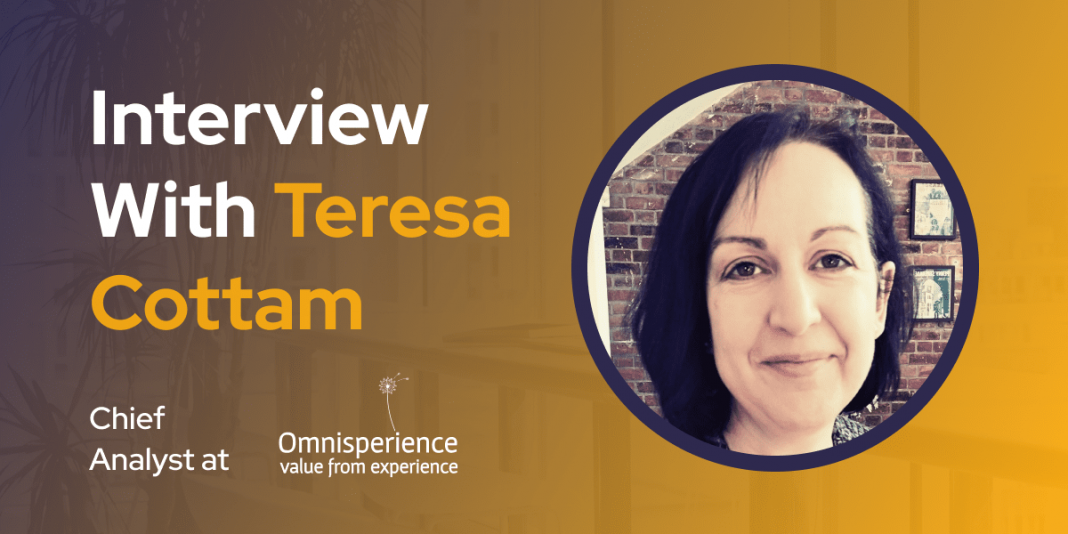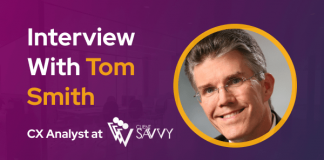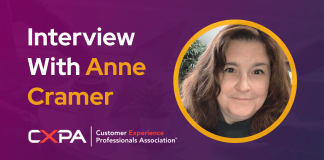Hi Teresa, tell us about yourself and your background
My name’s Teresa Cottam and I’m the Chief Analyst at telecoms analyst firm Omnisperience. I look at how telecoms firms can improve experience and customer service. Previously I was a principal analyst at Analysys Mason, Head of Publications & Research at Chorleywood Consulting and Managing Editor at Ovum. I’m a judge for the GSMA’s GloMo awards and the World Communications Awards. I have a MA from Sheffield University in Language and Linguistics and my Masters Degree was focused on spoken communication. When I’m not thinking about customer experience I’m drinking real ale and knitting.
What is the biggest misunderstanding about customer experience, in your opinion?
Wow there are a few. Customer service and customer experience are not the same thing! Service is just one single element of experience – an important one, but just one part of it. Another misunderstanding is that silent customers are the best customers. Firms often see experience and service as a cost so their goal is not to interact with them because that costs them money. This is so short sighted because it means your customers are disengaged and you’re missing out on opportunities to understand them, to build loyalty and to sell them other things they need. Another bug bear of mine is that experience is a journey. I just don’t think that’s the way the customer experiences it. A customer’s experience is richer and deeper than a lot of companies think, and it’s only partially visible to the service provider despite what the data tells them. It’s built in unique moments; not all the things customers experience have equal meaning to them; and they’re the ones in control these days not the service provider.
What are some of the newer CX companies/solutions you’re keeping your eyes on right now?
Customer experience is almost like a giant iceberg that’s really hard to get a handle on. So I’m focusing on two things currently. The first is customer communication. Within telecoms this is extremely fragmented and the outcome is often negative, frustrating and not what the telecoms firm intended. There’s a lot of work to be done to ensure that the overall interaction between the customer and the service provider is coherent and as intended. The second thing I’m looking at is the future of experience. We’re busy rolling out 5G networks and delivering 2G experiences. Customers expect not just efficiency nowadays but innovation in experience. So following on from our successful programme on Experience 2025 which we published back in 2016, I’m now thinking about Experience 2030. In terms of channels I’m excited about voice 2.0 and how that helps make things more inclusive.
Teresa’s tips for improved customer loyalty
What can companies do to improve customer loyalty and retention?
These are not the same things. You can retain customers without having any loyalty from them by tying them into contracts, for example. If you really want loyalty then the most basic thing is to treat the customer as though you value their business. In telecoms a good example of how we don’t respect our customers is by giving new customers better deals than existing ones. That is a huge slap in the face and goes counter to what customers expect. Everyone expects better treatment when they’ve been with someone a long time. That customer is also likely to be more profitable for your business. Giving new customers the best deals is counter-intuitive and drives churn. It’s both illogical and expensive.
What do you think is most relevant and why: CSAT (Customer Satisfaction Score), NPS (Net Promoter Score), or CES (Customer Effort Score)?
Of those three I like CES and I think it’s underrated. I’m not really a great believer in CSAT and NPS. I don’t think you can measure satisfaction in that way and I find that companies that over-rely on these are generally complacent. You can drive up experience by throwing money at it, for example, but that doesn’t make it commercially good experience. Making things easier for the customer, however, is something we can measure and should. If we think about this as human beings, rather than as customer experience professionals, it’s much more tangible for us to assess if doing something specific was hard or easy, rather than being asked about a less tangible concept such as happiness or satisfaction which is multi-dimensional, idiosyncratic and highly dynamic. In simple terms it’s the same as asking me: Did you like those chocolates? versus Are you happy with chocolates?
How can companies better use social media in the era of customer-centricity and personalization?
I think what social media adds is interactivity and immediacy. I think where it’s still problematic is its separateness. SM may be integrated into the call centre but it’s not fully converged into other channels. That means as soon as things get real, the customer is going to be asked to switch channel with all the hazards that brings. As a customer I want the person interacting with me on social to be the person that takes me through the whole interaction. I don’t want nice SM person that I’m vibing with to hand me over to another team member who I don’t know. The whole experience just went cold from my perspective when that happens.
What is your opinion on AI-based chatbots to handle customer support?
Chatbots are great for handling everyday queries but there should always be a default back to humanity and we have to accept that they can only handle known queries. What that means is that the queries, complaints and other issues being directed at the call centre are going to be more complex in future – because AI will mop up all the easy stuff. This has profound consequences for the call centre, but even at the level of the chatbot, the chatbot needs to be a gateway to self-care not a barrier. If it becomes another frustrating experience (like IVR did) then people will avoid using them.
What was the best movie you saw that has come out during this past year?
I spent most of last year box-setting on Amazon. I like the continuity of story and the familiarity which means I can also knit while I watch. 🙂 I enjoyed The Expanse – I liked the idea that even when we go into space, humans are still argumentative, difficult and fallible, but also brave, kind and noble.
Last but not least, what is your favorite CX metric?
I like CLV because it’s quite a rich metric that tells you a lot about your relationship with your customer over time; but I also like to measure agent turnover. I think good customer experiences rely heavily on good employee experience. A high agent attrition rate suggests to me that a company sees experience as a cost not an investment. There are commercial and operational reasons to reduce staff attrition, but I also believe that how companies treat their staff is going to be a big element in whether customers choose to do business with them in the future.






